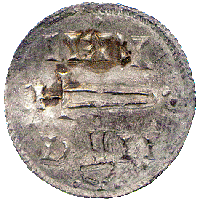
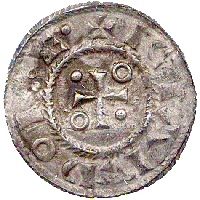
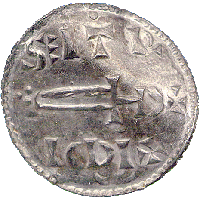
Blood and the Vikings:
Swords and Crosses on Anglo-Scandinavian Coins
"...the pagans desecrated the sanctuaries of God, and poured out the blood of saints around the altar, laid waste the house of our hope, trampled on the bodies of saints in the temple of God, like dung in the street."
The Vikings' reputation is of fearsome pagan warriors, who caused destruction across Western Europe by their raids. However, by the late ninth century, in large areas of the British Isles, the Vikings had turned from raiding to settling. Between 876 and 954 the Viking kingdom of York flourished and its rulers struck their own coins.
At first glance, the imagery of the coins struck by the Norse kings of York seems to bear out the violent and pagan identity of the Viking invaders. These are two coins struck by Sihtric (921-7), which were recently found as part of a hoard in the parish of Thurcaston, about five miles north-west of Leicester. They were struck in Sihtric's territory in the East Midlands, perhaps at Lincoln. Both coins have swords prominently on the obverse and there is a hammer - symbol of Thor - below the sword on the first coin. Each coin gives Sihtric's name in garbled Latin: SETR/ ICDI+ (for SITRIC REX) on the second coin. This coin was bent during the Viking period and only the obverse is shown here.

|

|
|

|
||
In fact, many of the Vikings who settled had been converted to Christianity within a generation. Pagan symbols on the coins produced in Viking-Age York were actually few and far between - and even on these coins they are combined with Christian symbols (there are little crosses next to the sword, as well as the crosses on the reverses of these coins). The great majority of Anglo-Scandinavian coinages were self-consciously Christian: for example in c. 900 the then ruler of York, called Cnut, was striking coins with a cross and his name laid out in the form of a cross (to read it follow the letters C - N - V- T from top to bottom and left to right).
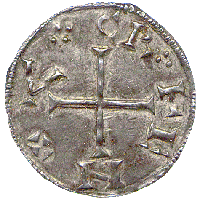
|
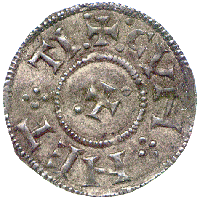
|
It seems that the Viking symbols only began to be used on the coins as a statement of a separate Northern identity, in response to increasing military pressure on the kingdom of York from the English king, Edward the Elder, from about 919. This distinctive Anglo-Scandinavian identity also attracted local non-Viking Christians: for example, the Archbishop of York sided with the Viking ruler against the English king in a dispute in 939-40.
But it was not just Christianity which the Vikings had rapidly adopted from local people. The striking of coins was not a native Scandinavian practice at this time: the Vikings instead valued silver by weight, as is revealed by the finds of weights and scales, and of hoards containing cut silver objects (known as hacksilver) as well as coins, both in Scandinavia and the areas where the Vikings settled. The Viking rulers of York quickly took up the local English custom of striking coins, as a sign of their authority, a source of revenue, and to make trading easier for those of their subjects accustomed to using coins.
These two coins of Sihtric were found recently by Mr Brian Kimberley, a metal detectorist. Finds like these have transformed our understanding of the early medieval period, and of the Vikings in England. The Thurcaston hoard, of 12 coins hidden c. 925, includes Anglo-Scandinavian coins from York and the East Midlands, English coins and Arabic dirhams. It suggests that a 'dual economy', in which both coins and silver bullion were used, continued to flourish in this area, even after it was retaken by Edward the Elder in the 918. This suggests the limits of Edward's control of the area: in the heart of his kingdom only his own coins would have been valid in transactions.
Evidence like this from the coins helps to illuminate tricky historical questions such as the impact of Viking settlement in the Danelaw. Projects such as the Early Medieval Corpus project here at the Fitzwilliam Museum, and the Portable Antiquities project, have been set up so that metal detector finds like these can be recorded and interpreted for posterity.
For more information on the Vikings, follow this link to the BBC website accompanying the new series, Blood of the Vikings: www.bbc.co.uk/history/programmes/bloodofthevikings/index.shtml